Andrew Paul Wood – 11 February, 2011
The Flanagan/Robinson counterpoint reveals each artist's relative weakness - Flanagan sometimes overthinks his art, while Robinson occasionally underthinks it. They are good for each other
Christchurch
Scott Flanagan and James Robinson
20 Years of Domestic Art
1 February 2011 - 12 March 2010
At first glance it would appear that this exhibition in a basement space that claustrophobically barely clears the top of my head, is a strange and unlikely pairing. Scott Flanagan is known for intellectually rigorous, multi-referential, scrupulously crafted conceptual bricolage that frequently employs Duchampian alter egos and grids in the form of weaving and crossword puzzles - oh, and soft porn. James Robinson, on the other hand, is a chaotic, cathartic artist working in an enthusiastic neo-expressionist mode recalling the hairy-chested excesses of Julian Schnabel, with a certain amount of pseudo-sado manqué-maudit “outsider” posturing and romantic hype. Flanagan is abstract ideas, Robinson is raw emotion - or at least, that’s the official line.
And yet it works. Both artists have adopted specific positions in relation to the twentieth century avant-garde; particularly it would appear Dada, Surrealism, Arte Povera, Art Informel, Art Brut, Lettrism, CoBrA and Fluxus. There are elements, too, of the Existentialism of Germaine Richier and Jean Fautrier, the Neo-Dada of Robert Rauschenberg and Jasper Johns, Funk artists like Bruce Conner, Nouveau Réalisme, and the Josephs Kosuth and Beuys. The art is assembled from the found, like detached images bubbling up from the Unconscious. Both artists are enthusiastic, disciplined, and deadly serious about the culture of art and art-making. Both are autodidacts, which may be one of the most significant facts in the case, and although Robinson earned a BFA from Otago School of Fine Arts in 2000, neither artist shows much evidence of allowing classical training to clutter up their headspace with fluff and lumber. This spares them a lot of the homogenised international art-worlditis that afflicts others. The art is scruffy, sinewy, earnest, urgent and has no time for polite niceties or a cup of tea with the vicar. It doesn’t so much have its finger on the pulse of the art world as hold open a sharp razor to its jugular while going for its wallet.
All of the work is interesting, but most of it is not new. Robinson’s nails and black velvet on encrusted canvass, and Flanagan’s collage and weaving are largely recognisable from other solo exhibitions earlier in the decade and in Flanagan’s case some go back to the previous century. What gives this show a novum and lustre of newness is the synergy of the two artists together - there is frisson. Much to my surprise, the works talk to each other by coming from very different processes. Particularly enjoyable is Robinson’s (in collaboration with Rowan Wernham) shonky stop-motion video X Ogenesis. The Flanagan/Robinson counterpoint also reveals each artist’s relative weakness - Flanagan sometimes overthinks his art, while Robinson occasionally underthinks it. They are good for each other.
I would have liked to have seen some newer stuff from Flanagan. I’m curious to see how his time as a New Zealand Asia Foundation artist in residence in Korea has been, and will further be digested, but suitably rewarding were the two mixed media works that Flanagan and Robinson worked on together: Ecological collapse and Alien help, both 2009. These underline the success and mutual respect evident in this artistic relationship. The mutual language of collage and bricolage works well, both artists serving to moderate the excesses of the other, but suggesting distinctly et al-esque possibilities. I would love to know how this all came about. At what point did the artists recognise that they had something in common and should do something about it.
Upstairs in the welcome light and air of NG’s café and boutique (the most logical and efficient deployment of space for Ladies Who Lunch) is a separate exhibition of new painting by Robinson. The thickly impastoed Merzbau-ish surfaces encrusted with snapped up unconsidered trifles are still there, but now with the introduction of a sickly palette of ice-cream colours that distracts disagreeably from the formal qualities of the paint’s sculptural texture. I must, though, confess a personal preference for the older monochromes with their painted moonscapes, Frankenstein suturing and elaborate Basquiat-esque drawing. These Robinson appears to have forsaken in pursuit of a perhaps misguided painterly credibility. But before I can turn around, the movie ends; the artist rides off into the darkening night of the soul and all I can do is plaintively cry out in my prepubescent treble, “Shane!”
Andrew Paul Wood
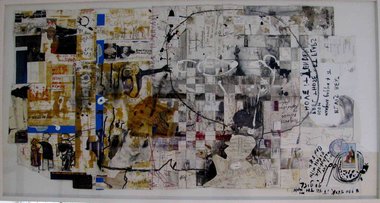
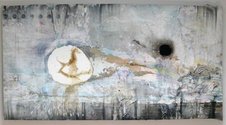
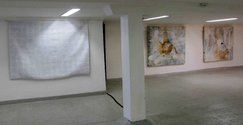

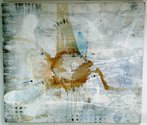
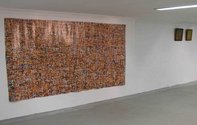

 Advertising in this column
Advertising in this column Two Rooms presents a program of residencies and projects
Two Rooms presents a program of residencies and projects



This Discussion has 0 comments.
Comment
Participate
Register to Participate.
Sign in
Sign in to an existing account.